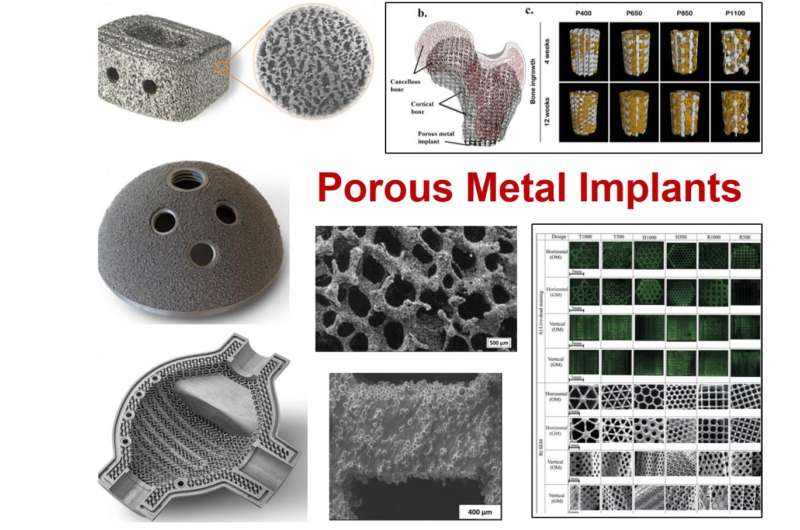This article has been reviewed according to Science X's editorial process and policies. Editors have highlighted the following attributes while ensuring the content's credibility:
fact-checked
proofread
Investigating the porous metals in orthopedic implants and beyond

Prof. Amit Bandyopadhyay's group from Washington State University presents a knowledge-based discussion of the challenges and possible future directions for the fabrication and application of porous metallic implants.
The review, published in the International Journal of Extreme Manufacturing discussed and compared various manufacturing methods for porous or functionally graded metals, specifically, how the manufacturing process influences microstructure, graded composition, porosity, biocompatibility, and mechanical properties.
Most of the studies discussed in this review are related to porous structures for bone implant applications; however, the understanding of these investigations may also be extended to other devices beyond the biomedical field.
"Although the commercial investigation into porous metals began in 1925, the progress was slow until the 1980s. Since then, the widespread commercial availability of different porous metallic materials for various applications has steadily increased. In recent years, porous and functionally graded materials have seen extensive applications in orthopedic and dental implants," said Prof. Amit Bandyopadhyay, the Boeing Distinguished Professor at Washington State University. He is the first and corresponding author of the review.
Research has shown that once the advantages of porous metallic structures in biomedical devices have been realized, their biological and biomechanical compatibility—with the host bone—has been followed up with extensive research. Using porous metals for orthopedic implants began with osseointegration devices. One challenge associated with implantation into a more youthful society is that the implants will most commonly undergo more significant mechanical stresses with an increased exposure rate.
"Therefore, a push for improved implant performance and lifespan is imperative; investigating and innovating porous metallic implant structures with stiffness closer to bone and interconnected porosity is deemed highly significant. These implants should promote metabolite and nutrient exchange and allow bone ingrowth leading to improved implant-tissue anchorage and interfacial strength. Mechanical properties and the applicability of porous structure for load-bearing implantation sites depend highly on factors such as pore interconnectivity, open porosity, pore size, phases present, compositional variations, grain size, etc.," Prof. Bandyopadhyay commented.
Most studies investigating porous metal applicability as an implant or studying a novel fabrication technique focus on and evaluate the mechanical properties, corrosion resistance, fatigue resistance, and biological compatibility, all of which are directly linked to the cell morphology, factors of which have an influence onto cell attachment and integration into the host tissue.
Prof. Bandyopadhyay's research interest lies at the interface of materials science and engineering, advanced manufacturing technologies, and biomedical engineering, emphasizing 3D Printing (3DP) or additive manufacturing for load-bearing implants, bone-tissue engineering, and materials for space and aerospace structures. Dr. Bandyopadhyay has continued to work in the 3D Printing field since 1995. He has consistently sustained his research activities in this field for over 28 years and has become a recognized leader.
He has published over 370 technical articles and is the inventor of 21 issued patents.
In 2003, Prof. Bandyopadhyay and his team proposed the concept of "3D Printed (3DP) porous metals for load-bearing implants" to the W. M. Keck Foundation and received a grant to initiate that research at WSU. Over the years, he and his research team have published many papers on this concept and received a few US patents.
That concept has now been accepted worldwide, and in 2021, over 150,000 porous metal implants were manufactured via metal 3DP worldwide for human use. Perhaps this is Prof. Bandyopadhyay's most significant research contribution in his career.
Prof. Bandyopadhyay is a fellow of the American Association for the Advancement of Science (AAAS), Society of Manufacturing Engineers (SME), National Academy of Inventors (NAI), American Society for Materials (ASM International), American Institute for Medical and Biological Engineering (AIMBE) and American Ceramic Society (ACerS). Prof. Bandyopadhyay was elected to the Washington State Academy of Sciences (WSAS) in 2017.
Prof. Bandyopadhyay said, "In the next 10 years, 3D Printed porous metallic implants for hip, knee, spinal, craniomaxillofacial, and dental applications are expected to increase from 150,000/year to 4 million/year worldwide. Such unprecedented growth in porous metal implants will come from traditional implants, innovative implant designs, and intelligent implants with sensors that can provide real-time feedback to clinicians."
"Understanding processing-properties interactions are critical to maintaining reliability and reproducibility in manufacturing these implants, a focus of this critical review article designed for engineers, scientists, clinicians, and business leaders."
More information: Amit Bandyopadhyay et al, Porous metal implants: processing, properties, and challenges, International Journal of Extreme Manufacturing (2023). DOI: 10.1088/2631-7990/acdd35
Provided by International Journal of Extreme Manufacturing





















